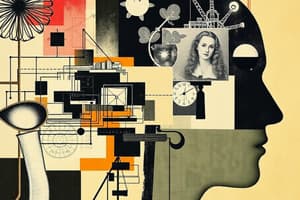Podcast
Questions and Answers
What is the main focus of Empiricism in art?
What is the main focus of Empiricism in art?
- Exploring human experiences and emotions (correct)
- Focusing solely on the artist's internal thoughts
- Creating art based on perfect ideals
- Representing abstract concepts without observation
Which of the following is a con of Empiricism?
Which of the following is a con of Empiricism?
- It effectively captures abstract ideas
- It fosters a deep connection with nature
- It limits understanding of complex ideas (correct)
- It can lead to objective observations
What is a key characteristic of Idealism in art?
What is a key characteristic of Idealism in art?
- Emphasizing subjective interpretations
- A focus on sensory experiences
- Using observation as a primary tool
- Representing things in their perfect form (correct)
Which philosopher is known for contrasting sentiment and judgment in art?
Which philosopher is known for contrasting sentiment and judgment in art?
What does the term 'solipsism' refer to in the context of Idealism?
What does the term 'solipsism' refer to in the context of Idealism?
Which approach characterizes the Empiricist method in art-making?
Which approach characterizes the Empiricist method in art-making?
What is a potential benefit of Idealism in art?
What is a potential benefit of Idealism in art?
What is a limitation of empiricism in terms of observation?
What is a limitation of empiricism in terms of observation?
How does idealism in art aim to approach beauty?
How does idealism in art aim to approach beauty?
What key advantage does Empiricism offer to artists?
What key advantage does Empiricism offer to artists?
What are the components that Hume believed contribute to developing good taste?
What are the components that Hume believed contribute to developing good taste?
Which type of art did Hegel consider to be the highest form?
Which type of art did Hegel consider to be the highest form?
What does the term 'Geist' signify in Hegel's philosophy?
What does the term 'Geist' signify in Hegel's philosophy?
How did Hegel classify the evolution of art?
How did Hegel classify the evolution of art?
What key characteristic differentiates Romantic art from earlier forms according to Hegel?
What key characteristic differentiates Romantic art from earlier forms according to Hegel?
Which aspect does NOT contribute to Hume's definition of good taste?
Which aspect does NOT contribute to Hume's definition of good taste?
Which statement best describes Hegel's view on the role of art?
Which statement best describes Hegel's view on the role of art?
What was Hegel's perspective on Symbolic art?
What was Hegel's perspective on Symbolic art?
What factor is emphasized as important for developing good taste in art according to Hume's theory?
What factor is emphasized as important for developing good taste in art according to Hume's theory?
According to Hegel, what is the significance of different art forms evolving over time?
According to Hegel, what is the significance of different art forms evolving over time?
Flashcards
Right or Wrong Judgments in Art
Right or Wrong Judgments in Art
Judgments about art that can be objectively debated, like whether a painting uses proper perspective.
Sentiment in Art
Sentiment in Art
Personal feelings about art, which can't be argued about because they are subjective.
Hume's Theory of Good Taste
Hume's Theory of Good Taste
Hume's belief that good taste is developed through careful observation, practice, comparison, and open-mindedness.
Delicacy in Art
Delicacy in Art
Signup and view all the flashcards
Practice and Taste in Art
Practice and Taste in Art
Signup and view all the flashcards
Comparison in Art Appreciation
Comparison in Art Appreciation
Signup and view all the flashcards
Absence of Prejudice in Art
Absence of Prejudice in Art
Signup and view all the flashcards
Geist
Geist
Signup and view all the flashcards
Art as Embodiment of Geist
Art as Embodiment of Geist
Signup and view all the flashcards
Art Evolution and Geist
Art Evolution and Geist
Signup and view all the flashcards
Idealism in Art
Idealism in Art
Signup and view all the flashcards
Empiricism in Art
Empiricism in Art
Signup and view all the flashcards
Sensory-Based Approach
Sensory-Based Approach
Signup and view all the flashcards
Limitations in Understanding Abstract Ideas
Limitations in Understanding Abstract Ideas
Signup and view all the flashcards
Subjectivity of Observation
Subjectivity of Observation
Signup and view all the flashcards
Revealing Truth Through Aesthetics
Revealing Truth Through Aesthetics
Signup and view all the flashcards
Solipsism in Idealism
Solipsism in Idealism
Signup and view all the flashcards
Standards of Taste
Standards of Taste
Signup and view all the flashcards
Judgment in Art
Judgment in Art
Signup and view all the flashcards
Study Notes
Empiricism and Idealism in Art
- Empiricism views art as stemming from human experiences and emotions.
- It emphasizes observation and how artists use their sensory experiences to create art.
- This approach focuses on how people actually experience and create art rather than perfect ideals.
- Sensory-based approach is grounded in the real world.
- Limitations include difficulty in explaining abstract ideas and subjectivity of observation.
- Idealism focuses on perfect and beautiful forms of art.
- It aims to capture the essence of beauty, harmony, and perfection.
Philosophers on Art and Taste
- David Hume believed in empiricism and established standards of taste.
- He differentiated between personal feelings (sentiment) and reasoned judgments about art.
- Hume's standards of taste involve delicacy, practice, and comparison.
- These steps help develop refined taste in appreciating art.
- Georg Wilhelm Friedrich Hegel focused on Geist (mind/spirit).
- Hegel believed art evolved over time, revealing more of the Geist.
- Hegel's stages of art development include symbolic, classical, and romantic.
Conclusion: Art as a Reflection of Ourselves and the World
- Hume and Hegel's ideas show how our perceptions of art have evolved.
- Art reflects changes in society and values.
- Art continually evolves, leading to new interpretations of beauty and symbolism.
- Alice Guilermo emphasizes continuous change and creation of new meanings.
- Dialectics (contradictions) in society highlight the evolving role art plays in interpretation.
- Art connects us to the world and ourselves.
Studying That Suits You
Use AI to generate personalized quizzes and flashcards to suit your learning preferences.




